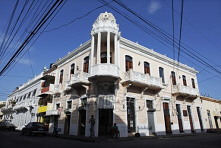
Typical street scene in Santa Ana, El Salvador. (Photo: iStock)
IMF Survey: Central America Should Deepen Reform to Lift Growth
August 8, 2011
- Changes in global outlook present new challenges for Central America
- Strengthening expenditure efficiency, raising tax revenues are key priorities
- Boosting competitiveness critical to place region on higher growth path
Sustained economic growth is necessary to increase the living standards of the people of Central America.

Central Santo Domingo, Dominican Republic. Central America responded well to global economic crisis, conference heard (photo: Eduardo Munoz/Reuters)
REGIONAL CONFERENCE
Against a backdrop of weak external demand, stronger policy frameworks and continued structural reforms will be key to unleashing the productivity gains needed to meet that challenge.
This was the overarching theme of the 10th Regional Conference on Central America, Panama and the Dominican Republic held in Managua July 28–29. The conference was attended by the main economic authorities from seven countries of the region and co-sponsored by the Central Bank of Nicaragua, the region’s Monetary Council, Council of Finance Ministers, Council of Financial Superintendents, and the International Monetary Fund (IMF).
Nemat Shafik, Deputy Managing Director of the IMF, noted that the region had responded well to the global economic crisis. But she added it must now do more to ensure that economic policy translates into jobs and higher living standards. “Macroeconomic stability is not enough if it does not deliver social outcomes—jobs, poverty reduction, a sense of fairness—that creates political stability,” she said in a keynote speech.
The annual conference for Central America is a long-standing regional discussion forum, and one of the few where the principal country authorities gather with IMF staff to analyze recent developments and exchange views on key challenges and policies. To facilitate the discussion, IMF staff prepared short background documents on the challenges for growth, fiscal policy, monetary policy, and financial sector issues in the region.
Global outlook and regional priorities
Olivier Blanchard, the IMF’s Economic Counsellor, opened the conference sessions with a presentation on the global outlook. He explained that the advanced economies, particularly the United States, were not likely to grow fast in the years to come and that global growth was likely to continue be driven by the large emerging countries. Partly for this reason, he noted that commodity prices were likely to remain high. He also noted that the daunting fiscal challenges in Europe and United States presented risks for global financial stability.
Against this backdrop, Nicolás Eyzaguirre, Director of the IMF’s Western Hemisphere Department, discussed the appropriate policy responses and reform priorities for the Central American region. He emphasized the need to strengthen the frameworks for macroeconomic policy and financial sector supervision and regulation, and to push ahead with structural reforms to boost competitiveness and growth.
He highlighted the importance of giving priority to rebuilding the fiscal defenses used during the global crisis; strengthening the monetary policy framework by increasing exchange rate flexibility; improving financial regulation and supervision; and adopting competitiveness-enhancing reforms.
Fiscal challenges
Miguel Savastano, Deputy Director of the IMF’s Western Hemisphere Department, reviewed the recent fiscal performance of the region and the options going forward. He noted that the level of government expenditure in the region was not too high, from an international perspective, but its composition was too tilted towards current expenditure and had to be rebalanced.
Savastano then argued that the task of regaining “fiscal space” by rebuilding budgetary cushions would depend primarily on the ability of mobilizing higher revenues, through a combination of higher tax rates, lower exemptions, and improved tax administration
Structural reform agenda
Marco Piñón, Chief of the Central American Division of the IMF’s Western Hemisphere Department, presented evidence showing that in order to increase growth Central America had to become more attractive for private investment, which required improvements in human capital and increasing competition in key sectors such as telecommunications, electricity, and agriculture.
He also argued that stronger monetary policy frameworks and improvements in financial supervision and regulation, particularly in the areas of risk-based supervision and supervisory perimeter, would be growth-enhancing in the region.
In her keynote speech, Shafik highlighted the risks of neglecting structural reforms.
“Most countries in Central America … [have] achieved relative macroeconomic stability but against a backdrop of low productivity and slow improvement in living standards,” she said.
“It should be a priority for all the governments of Central America … that their citizens never become … disenfranchised ... [for this] it is imperative to press ahead with structural reforms to set the region on a path of high and sustained growth.”


